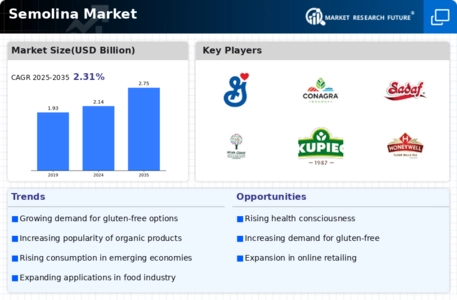Top Industry Leaders in the Semolina Market

The competitive landscape of the semolina market is shaped by a combination of established players and dynamic factors such as agricultural practices, supply chain efficiency, and evolving consumer preferences. To provide a comprehensive understanding of the competitive scenario in this sector, an analysis is required, including the strategies adopted, market share factors, news related to emerging companies, industry trends, current investment patterns, and the overall competitive landscape. Key players in the semolina market have strategically positioned themselves to meet the global demand for wheat-based products and capitalize on the versatile applications of semolina in the food industry.
Key Players:
General Mills Inc. (US)
Conagra Brands (US)
ARDENT MILLS (US)
Gilchester Organics (UK)
Shree Kailash Grain Mills Pvt. Ltd (India)
SADAF FOODS (US)
MISKO (Greece)
Kupiec (Poland)
Honeywell Flour Mills (Nigeria)
Europasta SE (Czech Republic)
Strategies Adopted:
Strategies adopted by key players in the semolina market revolve around vertical integration, sustainable sourcing, and technological advancements. Bunge Limited, for instance, has strategically focused on vertical integration, controlling various stages of the supply chain from wheat sourcing to semolina production. Archer Daniels Midland Company emphasizes sustainable sourcing practices, collaborating with farmers to ensure responsible agricultural practices and the production of high-quality wheat. Grain Millers, Inc. has adopted a strategy of technological advancements, investing in advanced milling technologies to enhance the efficiency of semolina production. Emerging companies like Ardent Mills differentiate themselves through a focus on specialty semolina products and adopting sustainable milling practices.
Market Share Analysis:
Market share analysis in the semolina sector involves evaluating various factors, including production capacity, distribution networks, and quality control measures. Established players like Bunge Limited and Archer Daniels Midland Company, with their widespread operations and global reach, often command a significant market share. Emerging companies strive to gain market share by investing in state-of-the-art milling facilities, ensuring consistent product quality, and exploring niche markets for specialized semolina applications. Market share dynamics are also influenced by factors such as pricing strategies, customer relationships, and the ability to adapt to changing consumer demands for premium and sustainable food ingredients.
News & Emerging Companies:
Recent news in the semolina market includes the emergence of new companies and strategic collaborations. Emerging companies such as Ardent Mills have gained attention by introducing organic and non-GMO semolina products, aligning with the growing consumer demand for clean-label and natural ingredients. Collaborations between semolina producers and artisanal bakeries have become a notable trend, catering to the rising popularity of artisanal and specialty baked goods. Additionally, news surrounding the development of semolina-based pasta alternatives and gluten-free semolina options reflects the industry's response to diverse dietary preferences and the need for innovative semolina applications.
Industry Trends:
The industry is currently witnessing investment trends focused on sustainability, quality control, and diversification. Key players are investing in sustainable agricultural practices for wheat cultivation, ensuring a stable and environmentally responsible supply chain for semolina production. Investments in quality control measures include advanced testing and inspection processes to maintain the consistent quality of semolina products. Moreover, there is a trend towards investing in diversification initiatives, including the development of specialty semolina blends for specific culinary applications and exploring new markets for semolina-based products.
Competitive Scenario:
The overall competitive scenario in the semolina market is characterized by the industry's response to sustainability concerns, technological advancements, and the demand for diverse wheat-based products. Established players leverage their global reach, production capabilities, and supply chain efficiency to maintain and expand market share. Emerging companies focus on differentiation, innovation, and sustainability to capture market segments seeking premium and specialty semolina products. The market is influenced by factors such as the increasing popularity of Mediterranean and Middle Eastern cuisines, the rising demand for artisanal bakery products, and the growing awareness of the nutritional benefits of semolina-based foods. As the semolina industry continues to evolve, the demand for high-quality, sustainably sourced semolina provides significant growth opportunities for both established and emerging players.
Recent Development
The semolina market was the industry-wide commitment to reducing the environmental impact of wheat cultivation. Major players collaborated with agricultural experts and environmental organizations to promote sustainable farming practices, including the use of precision agriculture and reduced water and pesticide usage. This initiative aimed to address concerns related to the ecological footprint of wheat cultivation for semolina production. The development showcased the industry's acknowledgment of environmental challenges and the collective effort to align with broader sustainability goals.
Furthermore, there was a notable industry-wide effort focused on enhancing the nutritional profile of semolina-based products. Key players collectively invested in research and development to fortify semolina with additional nutrients, such as vitamins and minerals, to meet the growing demand for healthier food options. This development reflected the industry's response to evolving consumer expectations and the increasing importance of nutritional content in food choices. The competitive landscape in 2023 demonstrated a balance between established players adapting to sustainability standards and emerging companies driving innovation, resulting in a dynamic and competitive semolina market.


